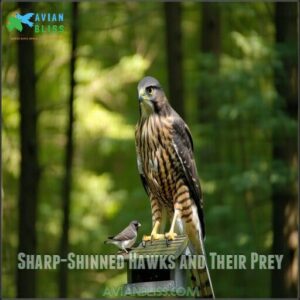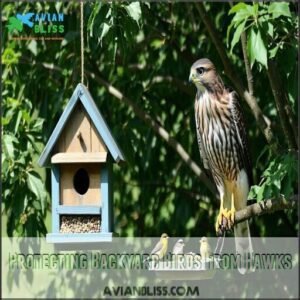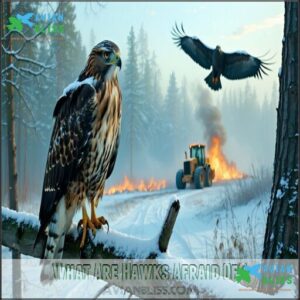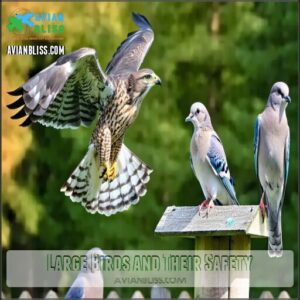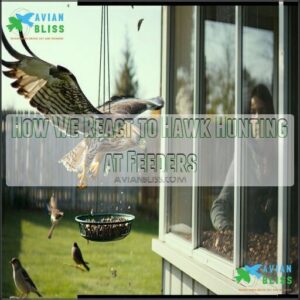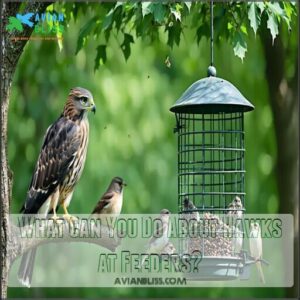This site is supported by our readers. We may earn a commission, at no cost to you, if you purchase through links.
 Hawks eat other birds because it’s a smart, efficient way for them to survive.
Hawks eat other birds because it’s a smart, efficient way for them to survive.
These birds of prey are opportunistic hunters, meaning they target what’s most available in their environment.
Small to medium-sized birds often make up a large part of their diet since they’re abundant, relatively easy to catch, and provide a good source of energy.
Hawks like Cooper’s hawks and sharp-shinned hawks are adapted to chase birds through trees at incredible speeds.
It’s nature’s way of keeping ecosystems balanced, even if it feels a little harsh.
Want to know which birds are most at risk around hawks?
Let’s explore.
Table Of Contents
- Key Takeaways
- Why Do Hawks Eat Other Birds?
- Hawks That Hunt Birds
- Protecting Backyard Birds From Hawks
- How Do Birds Know When a Hawk is Around?
- What Are Hawks Afraid Of?
- Which Birds Do Hawks Attack at Feeders?
- How We React to Hawk Hunting at Feeders
- What Can You Do About Hawks at Feeders?
- Living With Hawks in Your Backyard
- Frequently Asked Questions (FAQs)
- Conclusion
Key Takeaways
- Hawks eat other birds because they’re abundant, energy-rich, and easier to catch compared to other prey.
- These predators rely on sharp talons, hooked beaks, and exceptional eyesight to hunt birds efficiently.
- Smaller birds like sparrows and robins are frequent prey, though medium-sized birds like doves and woodpeckers aren’t safe either.
- Hawks help maintain ecosystem balance by controlling bird populations and aiding natural selection.
Why Do Hawks Eat Other Birds?

Hawks eat other birds because they’re reliable, protein-packed sources of energy in the wild. Their hunting skills and sharp vision make catching birds an efficient way to survive.
Birds are nature’s protein-packed energy bars, fueling hawks’ survival with every swift dive and sharp-taloned catch.
Hawks’ Diet and Hunting Habits
Hawks are master hunters, perfectly adapted to meet their dietary needs.
These birds of prey rely on sharp talons, hooked beaks, and their vision—eight times sharper than yours—to catch their meals.
Hunting isn’t easy, though; hawks succeed in just 1 out of 10 attempts. They don’t waste time—they pick prey based on ease and availability.
Here’s a breakdown of their hunting strategies:
- Ambush tactics: Surprise attacks from a perch or cover.
- High-speed pursuit: Dive and chase with explosive bursts of speed.
- Patient perching: Watch and wait before launching attacks.
- Seasonal variation: Adapt diets to available prey like birds, reptiles, or mammals.
Every catch is survival.
Types of Birds Hawks Prey On
In the context of birds hawks eat, their choices vary by species and hunting skills.
Sharp-shinned hawks often snatch songbirds like robins and sparrows, while Cooper’s hawks prefer medium-sized avian prey such as doves and woodpeckers.
Ground birds, like quail, face danger while feeding, and larger hawks target game birds or waterfowl like ducks and geese.
Even pigeons aren’t safe from their sharp talons.
Avian prey forms a key part of a hawk’s diet.
How Hawks Catch Their Prey
Spotting prey with vision eight times sharper than yours, hawks show unmatched precision.
Their hunting strategies revolve around ambush tactics and swift movements. Some wait perched on branches, striking with surprise. Others soar high, using aerial ambush tactics, diving at explosive speeds to outmatch their prey.
Their talon mechanics are built for capture success—hooked, sharp, and deadly. These tools, combined with powerful beaks, make birds of prey effective hunters across habitats.
- **Quick, efficient hunting techniques.
- **Incredible focus and sharp eyesight.
- **Lightning-fast dives for hawk prey.
- **Versatile ambush tactics from trees.
- **Dominance as apex predators in hunting techniques.
Hawks That Hunt Birds
Some hawks specialize in hunting other birds, adapting their skills to catch prey in trees or open spaces.
Species like Cooper’s Hawks, Sharp-Shinned Hawks, and Northern Goshawks are built for speed and precision, making them highly effective bird hunters.
Cooper’s Hawks and Their Prey
Cooper’s Hawks, part of the Accipiter family, are masters of bird predation with remarkable prey specialization and hunting techniques.
These agile hunters thrive in forests and urban settings, making neighborhoods their hunting grounds.
Their favorite meals include:
- Medium birds: Think doves, jays, and woodpeckers.
- Songbirds: Smaller targets when larger prey isn’t available.
- Ground-feeding birds: Caught off guard while foraging.
- Mid-air interceptions: Birds disoriented or fleeing.
With keen eyesight and explosive speed, Cooper’s Hawks skillfully navigate tight spaces like tree branches, reaching up to 25 mph.
Their urban adaptations extend to tracking bird feeders, where songbirds become easy prey.
These hawks play a key role in population dynamics, helping balance ecosystems efficiently.
Sharp-Shinned Hawks and Their Prey
The sharp-shinned hawk, an agile accipiter, thrives in dense forest habitats where its quick reflexes and focused tactics make hunting songbirds look effortless.
These small hawks favor sparrows, warblers, and other vulnerable songbirds, often targeting feeders for easy meals.
Their hunting success depends on speed and stealth, as they ambush prey from hidden perches.
Despite their compact size, sharp-shinned hawks can take down birds nearly their own weight, showcasing their precision and unmatched agility, especially within their forest-based hunting grounds.
Northern Goshawks and Their Prey
The Northern Goshawk, a masterful Accipiter and one of the most skilled birds of prey, showcases incredible hunting techniques across its forested domain.
These avian predators rule their Goshawk Hunting Grounds with stealth, speed, and unmatched agility, weaving effortlessly through dense canopies.
Squirrels, hares, and medium-sized birds, like grouse and woodpeckers, dominate their Goshawk Prey Variety.
During the breeding season, parents feed their chicks a Goshawk Juvenile Diet rich in protein-packed birds.
Goshawks rely on precision ambush tactics, where they perch silently, study movement below, and strike with lightning-fast dives that leave prey little chance to escape.
Their role in the ecosystem is essential, controlling populations of songbirds and small mammals, while their Goshawk Conservation Status depends on protecting mature forests.
They’re globally distributed, with concentrations in North America in Alaska, Canada, and the upper Midwest.
- Key facts about Northern Goshawks:
- Hunt across forest edges, open areas, and dense canopies
- Use explosive speed and sharp talons
- Prey includes squirrels, grouse, and pheasants
- Juveniles eat bird-heavy diets
- Essential for forest biodiversity balance
Protecting Backyard Birds From Hawks
Hawks are skilled hunters, but you can take simple steps to keep your backyard birds safe.
By providing shelter and adjusting feeders, you’ll make it harder for hawks to target them, this can be considered a simple step.
Providing Shelter for Birds
Giving your backyard birds a safe place to hide can help protect them from hawks, which are skilled avian predators.
Use natural shelters like dense shrubs, rock crevices, and brush piles or install artificial shelters like birdhouses.
Shelter placement is key—position these near feeders but away from open areas or tall perches where hawks can observe.
Opt for durable shelter materials like native plants or wood. A mix of dense vegetation and well-placed birdhouses provides predator protection by giving smaller birds quick escape routes.
For instance, birdhouses placed 5–15 feet high near thick shrubs work well as safe havens. You can find birdhouses for sale online.
Combining shelter with thoughtful feeder placement creates a sanctuary against bird consumption by hawks.
Shielding Feeders From Hawks
Shielding your bird feeders from hawks isn’t just a task—it’s a strategy that combines thoughtful placement with protective measures.
Hawks rely on speed and surprise, so creating obstacles limits their success.
Start with feeder placement. Position feeders near dense shrubs or trees (within 10-12 feet) to offer birds quick escape routes.
Proximity to shelter reduces stress and improves bird feeder safety.
Next, use deterrent methods. Try clear dome baffles or install feeder guards about 18 inches above feeders to block direct swooping dives.
Surround feeders with 2-inch mesh netting, allowing smaller birds to feed safely while keeping hawks out.
Avoiding Ground Feeders
Ground feeding can inadvertently turn your yard into a hawk’s buffet. To protect your feathered visitors and reduce predation, rethink your feeder placement and avoid ground feeders entirely.
Tray and platform feeders make it too easy for birds of prey to strike. Instead, opt for elevated feeders like tube or hanging ones, which offer better protection.
Place feeders near natural groundcover, shrubs, or small trees so birds have quick escape routes when predators appear. This simple habitat modification can act as a key deterrent strategy, dramatically decreasing hawk attacks.
Prioritizing bird feeder safety helps disrupt hawk eating habits, safeguarding vulnerable songbirds in your backyard.
Temporarily Removing Feeders
If hawks frequent your bird feeders, taking them down for 1-2 weeks could be a game-changer. This break interrupts hawks’ hunting patterns, encouraging them to explore new territories.
It may seem drastic, but it helps protect your feathered visitors.
Here’s how to manage feeder removal:
- Monitor bird behavior and their shift to natural foraging.
- Observe post-removal changes, ensuring fewer hawk visits before resuming feeding.
- Embrace community balance by reducing unnecessary risks to backyard birds while disrupting hawk eating habits.
It’s a win-win!
How Do Birds Know When a Hawk is Around?
You might wonder how birds sense danger when a hawk is nearby. They rely on sharp vision, alarm calls from others, and sudden changes in behavior to stay safe.
Warning Calls From Other Birds
Birds act like the neighborhood watch when a hawk is near, using warning calls to alert others.
Chickadees add extra "dee" notes to signal predators, while blue jays let out sharp, alarming squawks that scatter entire flocks.
These sounds aren’t random—they carry specific meanings to help others with predator recognition. Some birds even "eavesdrop," picking up on alarms from other species.
It’s a survival tactic that’s deeply tied to the evolution of alarm calls. In some cases, subtle high-pitched sounds urge others to freeze, avoiding detection.
You might also witness birds band together in collective defense, mobbing predators like hawks. It’s all part of the predator-prey relationship that keeps the ecosystem thriving.
Visual Cues From Hawks
Spotting a hawk before it strikes takes sharp eyes and a bit of instinct.
Birds can interpret subtle hawk behaviors that suggest danger:
- Eye Contact: If a hawk stares directly, it’s likely evaluating its next move.
- Feather Position and Stance: A perched hawk with tense posture signals hunting intent.
- Flight Patterns: A circling or hovering hawk often signals it’s zeroing in on prey.
These cues, combined with the hawk’s sharp vision and precise hunting strategies, keep birds constantly alert.
Hawks are often drawn to areas with high prey density, so increased vigilance is vital in those locations.
Changes in Bird Behavior
When a hawk’s nearby, you’ll notice birds shift their behavior.
Some freeze mid-movement, while others vanish into dense shrubs. Flocking changes fast—birds group up for safety, relying on numbers to confuse predators.
Vocalization shifts are another clue. Chickadees and jays send out sharp alarm calls that ripple through the area, warning others. This is classic anti-predator behavior in action.
Feeding stops abruptly as birds abandon perches. You’ll also see erratic flight patterns, making it harder for hawks to lock onto a target.
Here’s how behaviors adapt:
| Behavior | What Happens | Why It Helps |
|---|---|---|
| Freezing | Birds stay motionless | Avoids drawing attention |
| Flocking changes | Birds form tight groups | Safety in numbers |
| Vocal alarm calls | Loud warning signals spread rapidly | Alerts nearby birds of danger |
| Erratic flight | Flies unpredictably | Confuses predators |
These reactions highlight the fascinating predator-prey relationship between hawks and their potential meals, reinforcing the delicate balance of avian ecology.
What Are Hawks Afraid Of?
Even hawks, with their sharp talons and keen eyesight, have predators to watch out for. Larger birds, humans, and environmental changes can all make them feel threatened.
Predators of Hawks
Even the skies aren’t completely safe for hawks.
These birds of prey face dangers from several predators that disrupt the delicate predator-prey relationship.
- Owl Predation: Great horned owls raid hawk nests at night, targeting eggs and young hawks.
- Eagle Threats: Larger eagles attack smaller hawks, competing for food and territory in the ecosystem.
- Mammalian Predators and Snake Attacks: Foxes, raccoons, and snakes target hawk nests, feeding on eggs and nestlings.
These threats highlight hawks’ role in the food chain and ecosystem balance.
Some hawks also face dangers from larger canine predators.
Human Presence and Noise
Human activity isn’t something hawks enjoy. If you’re out chatting, mowing, or tinkering in your yard, you’ve likely disrupted a hawk’s hunting plans without even knowing it.
Hawks, especially urban ones coping with habitat fragmentation, grow cautious when they see you moving around or hear consistent noise. This hesitation is amplified by noise pollution’s impact on their sharp focus.
For backyard birds, your presence is like having a bodyguard. Hawks of prey, despite their skillful hunting techniques, prefer to avoid areas with too much human disturbance.
Whether it’s casual hangouts or tending bird feeders, those daily routines naturally shift the predator-prey relationship in your feathered friends’ favor.
Other Environmental Factors
Hawks might be fearsome predators, but they’re not immune to environmental challenges that disrupt their survival instincts.
Factors like habitat loss and urbanization effects force hawks into risky, unfamiliar areas. Climate change alters prey abundance, migration patterns, and the predator-prey relationship, making their hawk diet harder to maintain.
Meanwhile, storms reduce visibility and hunting success, while pesticide use poisons prey and impacts the food chain.
- Urban sprawl replaces hunting grounds with buildings and roads.
- Extreme weather disrupts natural selection in ecosystems.
- Polluted habitats weaken prey populations and limit hawk options.
- Shifting climates shrink access to reliable food sources.
Which Birds Do Hawks Attack at Feeders?
Hawks often target small and medium-sized birds at feeders because they’re easy to catch during feeding.
Species like sparrows, doves, and finches are especially vulnerable due to their size and predictable behavior.
Small Birds and Their Vulnerability
Small birds at feeders, like chickadees and sparrows, often find themselves on the menu due to their size and predictable routines.
Hawks capitalize on bird vulnerability, selecting prey that’s easy to catch within the predator-prey relationship. Habitat loss also plays a role, reducing natural shelters these birds rely on for safety.
Fledgling vulnerability is high—young birds are slower and less experienced in predator avoidance. Songbird defenses, like flocking and alarm calls, help but aren’t foolproof.
Dense vegetation can shield birds temporarily, but hawk behavior—perching silently or swooping with speed—makes escape difficult. Small birds face constant challenges in survival, reminding us how critical their defenses are in maintaining balance within the hawk diet ecosystem and their overall survival.
Medium-Sized Birds and Their Defenses
Medium-sized birds like doves and grackles rely on teamwork and agility to escape hawks.
Their sophisticated defense strategies include:
- Flocking Behavior: They stick together, issuing loud alarm calls to confuse predators.
- Evasive Maneuvers: Quick, unpredictable bursts of flight help outpace hawks.
- Camouflage Techniques: Staying near dense brush or trees limits visibility.
- Cooperative Defense: Birds share lookout duties, spotting hawks while others feed, balancing a delicate predator-prey relationship.
Large Birds and Their Safety
Big birds don’t scatter as quickly at feeders—they’ve got the upper hand against hawks.
Their size makes them tough targets, and most hawks won’t risk battling prey that can fight back. Large birds like crows, jays, and doves use clever defensive strategies to stay safe.
Here’s how they outsmart bird predators:
- Flock behavior: Feeding in groups means more eyes to spot a hawk, and mobbing can even chase hawks off.
- Camouflage effectiveness: Larger birds often feed in areas with natural cover, blending into the surroundings.
- Habitat selection: Staying near trees or shrubs offers a quick escape.
These tactics let them feed confidently, highlighting the balance between hawk behavior and the predator-prey relationship hovering over your feeders.
How We React to Hawk Hunting at Feeders
When you see a hawk hunting near your bird feeders, it’s natural to feel conflicted.
While you may worry about your backyard birds, it’s also a reminder of hawks’ essential role in the ecosystem.
Emotional Responses to Hawk Sightings
Watching a hawk swoop into your backyard is both thrilling and unnerving.
A hawk’s sudden dive into your yard is a breathtaking display of nature’s precision and raw survival instincts.
It’s hard not to feel awe and fear as the predator-prey relationship plays out right by your bird feeders. Your heart races as this majestic hunter targets smaller birds.
Yet, there’s a strange admiration for its sharp instincts and breathtaking precision. Personal experiences like these often ignite ethical considerations—should you step in or let nature unfold?
Over time, your shifting perspectives might lead to respecting the hawk’s role while understanding bird behavior better. Nature’s drama can stir emotions, leaving you fascinated by its balance and raw power.
Changes in Feeding Habits
Hawks adapt quickly to changes, making their hunting behavior at feeders hard to predict.
If you notice hawks targeting your yard, tweak your setup to protect smaller birds and disrupt their predator-prey relationship. Hawks thrive on prey availability and learn feeding schedules fast, especially in response to human intervention or urbanization effects.
- Place feeders near thick shrubs or trees, giving birds easy escape routes from sudden ambushes.
- Rotate feeding times to reduce predictability and limit hawk feeding habits.
- Use covered feeders that shield vulnerable species from aerial attacks.
- Remove open perches, minimizing hawks’ ambush opportunities.
Appreciation for Hawks’ Role in Ecosystem
You might feel uneasy about hawks hunting at your feeders, but they’re part of nature’s design.
Without hawks, the ecosystem balance would crumble. Their role as predators guarantees biodiversity support by culling weaker birds and aiding natural selection.
It’s not just about survival; it’s about strengthening species over time. Think of hawks as guardians of the food chain, maintaining ecological balance by keeping populations in check.
Plus, their hawk feeding helps manage pests, creating healthier, vibrant communities. So, while their presence may feel intrusive, hawks play a critical ecological role, reminding us of the beauty in conservation efforts.
What Can You Do About Hawks at Feeders?
If hawks are targeting birds at your feeders, there are simple steps you can take to help.
By making a few changes, you can protect smaller birds while maintaining a balanced environment for all wildlife.
Providing Alternative Food Sources
Shift your yard’s focus with supplemental feeding to reduce hawk activity.
Place rodent feeders or plant fruit and nut trees to attract squirrels and other prey—offering hawks alternative options. For controlled feeding, consider options like specially designed containers.
Add berry bushes to support small birds hawks typically avoid. Install hawkproof feeders or try suet feeders and mealworm dishes, creating safe, appealing spots for non-prey birds.
These small changes minimize hawk food sources while enriching habitats. Reducing attractants like exposed bird feeders helps achieve balance. With a little effort, you can create a bird-friendly zone while naturally deterring hawks.
Creating Hawk-Friendly Environments
Supporting hawks while keeping harmony in your yard is easier than you think.
By creating a welcoming environment, you’ll encourage healthy hawk behavior and bird conservation.
- Plant native trees and shrubs: Oaks or dense bushes provide nesting spots, roosting sites, and hunting perches.
- Add water sources: Clean bird baths attract prey and keep hawks hydrated, sustaining the ecosystem.
- Install nesting structures: Dead trees or nest platforms give hawks safe spaces to roost and raise young.
- Avoid pesticides: Healthy prey guarantees hawks have a steady hawk food source, while protecting smaller birds near your bird feeders.
A balanced backyard supports every layer of nature.
Deterrents for Hawks
Protect your backyard birds with smart hawk deterrents.
Use visual deterrents like reflective tape or fake owl decoys to scare hawks away. Auditory deterrents, such as ultrasonic devices, can effectively disrupt their hunting attempts.
Install physical barriers like mesh or cage feeders for bird defense strategies. Birds also use plumage camouflage methods to avoid being seen.
Position feeders near bird shelters like bushes for quick escapes, and trim high branches to prevent perching.
Here’s a quick guide:
| Strategy | Benefit | Example |
|---|---|---|
| Visual Deterrents | Startle hawks | Reflective tape, owl decoys |
| Auditory Deterrents | Interrupt hunting | Ultrasonic devices |
| Physical Barriers | Protect feeding birds | Mesh, cage feeders |
Habitat modification guarantees peaceful coexistence, combining hawk repellents with practical bird defense strategies.
Living With Hawks in Your Backyard
You might notice hawks more often in your yard as they adapt to suburban environments. Understanding their habits helps you coexist peacefully while appreciating their role in nature.
Coexisting With Hawks
Coexisting with hawks means understanding the predator-prey relationship while protecting backyard birds.
Small changes can help balance your space for both:
- Place bird feeders near shrubs or trees, giving birds a quick escape route from predators.
- Use natural deterrents like thorny bushes or baffles near feeding areas to discourage hawk relocation attempts.
- Avoid placing feeders in open spaces, where hawks easily spot prey.
By managing habitats thoughtfully and raising community awareness, you support ecosystem harmony and ethical considerations, which are key to creating a balanced environment where birds and hawks can coexist peacefully.
Appreciating Hawk Behavior
Watching hawk behavior in your backyard is a glimpse into nature’s brilliance.
These raptors showcase unmatched hunting adaptations, blending sharp intelligence with precision. Their actions highlight their ecological importance in balancing predator-prey relationships.
Here’s what to notice:
- Hunting Grace: Catch their swift dives and silent glides, perfect tools for observing hawks in action.
- Keen Focus: Watch their piercing gaze, a sign of incredible hawk intelligence.
- Behavioral Insights: Spot their territorial displays, feeding rituals, and connection to bird behavior.
Learning From Hawk Encounters
Watching hawks in your yard gives you a front-row seat to the predator-prey relationship.
You’ll notice their sharp movements, hunting strategies, and the way they impact bird behavior.
Observing hawk behavior helps you understand how they control avian prey populations, keeping a backyard ecosystem balanced.
Identifying hawk species lets you see differences in their hunting habits.
Understanding bird reactions, like flock warnings, connects you to nature’s rhythms—and shows hawks play a key role in maintaining balance.
Frequently Asked Questions (FAQs)
Do hawks eat other birds?
Hawks eat other birds because they’re carnivorous predators with sharp talons and hooked beaks perfect for hunting.
Birds, being abundant and nutritious, often become easy targets, especially vulnerable ones like fledglings or those near feeders, as they are preyed upon due to the hawks being carnivorous.
Do hawks eat pigeons?
Yes, hawks eat pigeons.
They’re an easy and plentiful prey option, especially in urban areas.
Hawks rely on their sharp vision, speed, and talons to catch pigeons in mid-air or snatch them from the ground.
Do hawks eat doves?
Doves often make an easy target for hawks.
Their size and slower flight compared to smaller birds make them appealing.
Hawks rely on doves as a significant protein source, especially if they frequent open spaces.
What do hawks use to catch their prey?
Don’t think hawks rely just on luck—they’ve got sharp talons to snatch prey and hooked beaks to finish the job.
Add their incredible eyesight, and you’ve got nature’s ultimate aerial hunter in action.
What do hawks consume as food?
They survive on meat, dining on birds, mammals, reptiles, and even insects.
Their sharp talons and keen eyesight make them top hunters.
A single meal fuels their energy for hours, keeping them skilled and efficient.
Do hawks eat hummingbirds?
Hummingbirds are like tiny missiles, fast and elusive, but hawks occasionally catch them.
It’s rare though, because hawks prefer less challenging meals.
Still, if a hummingbird slows or stops, it could become prey.
What does it mean when a hawk hangs around your yard?
When a hawk lingers in your yard, it’s hunting nearby.
Your area likely offers prey like birds or small mammals.
Hawks thrive where food’s abundant, making them nature’s efficient pest controllers and aerial guardians.
What do hawks eat?
Let’s face it, hawks are nature’s sharp-eyed opportunists.
They devour small mammals, reptiles, amphibians, and yes, birds.
Their diet depends on what’s around, making them adaptable predators with a knack for survival and protein-packed meals.
How do hawks kill their prey?
Hawks kill prey using sharp talons to grab and pierce critical spots, ensuring a quick death.
Their hooked beaks help tear flesh efficiently.
They rely on speed, surprise, and precision for successful hunting from powerful aerial ambushes.
Do hawks eat quails?
Quails make an easy target for hawks due to their size and ground-dwelling habits.
Their slower speed and tendency to feed in open areas leave them vulnerable to quick ambushes, making them a common prey choice.
Conclusion
Picture a hawk gliding effortlessly through the sky, focused and determined.
Their choice to hunt other birds isn’t random—it’s survival. By preying on small to medium-sized birds, hawks secure critical energy while maintaining balance in the ecosystem.
Understanding why hawks eat other birds helps you appreciate their essential role in nature. While it may seem harsh, it’s an efficient method for these hunters to thrive.
Observing hawks can teach you how interconnected and fascinating ecosystems truly are.
- https://www.nwf.org/Magazines/National-Wildlife/2016/OctNov/Animals/Hawks
- https://www.nationalgeographic.com/animals/article/how-many-birds-are-there-in-the-world-science-estimates
- https://www.ecori.org/natural-resources/2019/2/2/hawks-increasingly-feed-on-birds-at-feeders
- https://en.wikipedia.org/wiki/Buteo
- https://nhpbs.org/wild/thermals.asp


